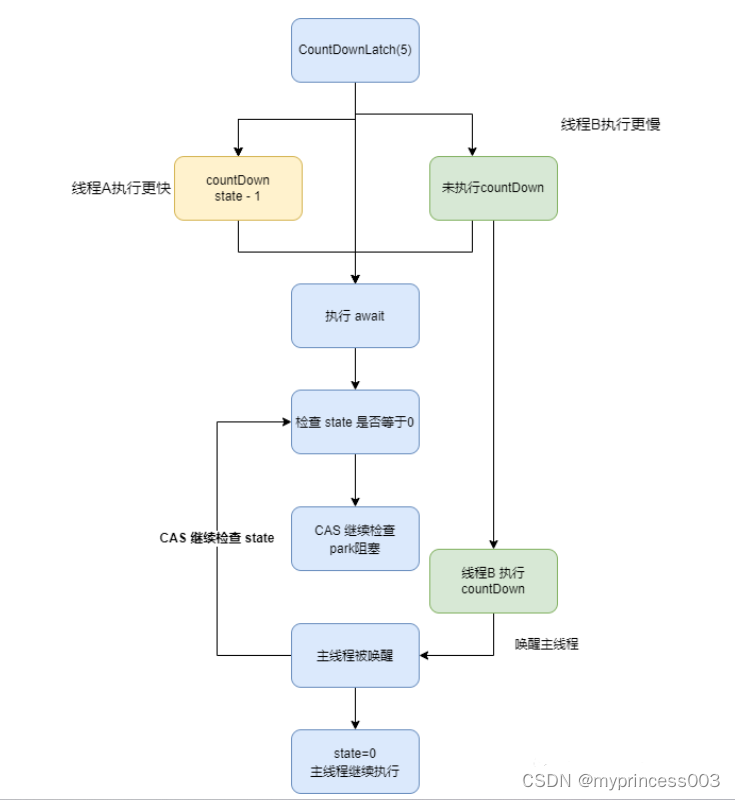-
CountDownLatch的原理
使用CountDownLatch可以实现等待多个线程执行完毕的功能,实现线程之间的协调,让它们按照我们期望的顺序执行,从而避免了可能出现的并发问题。
CountDownLatch是如何实现主线程等待子线程全部结束的呢?

代码用例
这里我们使用一段测试代码来理解它的原理,demo 如下:public static void main(String[] args) throws InterruptedException { int nThreads = 5; // 需要等待的线程数 CountDownLatch latch = new CountDownLatch(nThreads); Random random = new Random(); for (int i = 0; i < nThreads; i++) { new Thread(() -> { // 执行任务 System.out.println(Thread.currentThread().getName() + " is running..."); try { Thread.sleep(random.nextInt(5000)); } catch (InterruptedException e) { e.printStackTrace(); } System.out.println(Thread.currentThread().getName() + " finished..."); // 任务完成,计数器减1 latch.countDown(); }).start(); } // 等待所有线程执行完毕 latch.await(); System.out.println("All threads have finished."); }- 1
- 2
- 3
- 4
- 5
- 6
- 7
- 8
- 9
- 10
- 11
- 12
- 13
- 14
- 15
- 16
- 17
- 18
- 19
- 20
- 21
- 22
- 23
这个例子中,我们创建了一个CountDownLatch实例,并将需要等待的线程数设置为5。然后,我们启动5个线程来执行任务,每个线程执行的时间并不相同,并在每个线程执行完任务后调用 countDown() 方法将计数器减1。
最后,在主线程中我们调用 await() 方法来使当前线程等待,直到所有线程完成任务并计数器减为 0 为止。
原理
关键代码其实就三行。new CountDownLatch(5) 创建 CountDownLatch 实例,设置为state 为 5,相当于是个信号量。 latch.countDown()任务执行完成,分别减少 state。 latch.await()主线程检查其他线程是否全部执行完成,否则等待。- 1
- 2
- 3
信号量:那是多线程同步用的,一个线程完成了某一个动作就通过信号告诉别的线程,别的线程再进行某些动作。
互斥量:这是多线程互斥用的,比如说,一个线程占用了某一个资源,那么别的线程就无法访问,知道这个线程离开,其他的线程才开始可以利用这个资源。
创建对象
在创建 CountDownLatch 实例的时候,传入一个参数 5。它实现了内部类 Sync, 并且 Sync 继承了 AbstractQueuedSynchronizer(AQS)类。这里设置的 State 其实就是 AQS 中的 state 成员变量。public CountDownLatch(int count) { if (count < 0) throw new IllegalArgumentException("count < 0"); this.sync = new Sync(count); } //CountDownLatch.Sync Sync(int count) { setState(count); }- 1
- 2
- 3
- 4
- 5
- 6
- 7
- 8
执行countDown
设置完线信号量之后,在每个线程执行结束后会执行 latch.countDown()将 state 减一。private final Sync sync; public void countDown() { sync.releaseShared(1); } public final boolean releaseShared(int arg) { if (tryReleaseShared(arg)) { doReleaseShared(); return true; } return false; }- 1
- 2
- 3
- 4
- 5
- 6
- 7
- 8
- 9
- 10
- 11
在 releaseShared 方法中,他会尝试 state 减1,这里是一个死循环,也就是自旋锁。通过CAS的方式线程安全的修改 state的值,如果不成功,就通过自旋锁不断去尝试。
private static final class Sync extends AbstractQueuedSynchronizer { protected int tryAcquireShared(int acquires) { return (getState() == 0) ? 1 : -1; } protected boolean tryReleaseShared(int releases) { // Decrement count; signal when transition to zero for (;;) { int c = getState(); if (c == 0) return false; int nextc = c-1; //CAS if (compareAndSetState(c, nextc)) return nextc == 0; } } }- 1
- 2
- 3
- 4
- 5
- 6
- 7
- 8
- 9
- 10
- 11
- 12
- 13
- 14
- 15
- 16
- 17
- 18
- 19
在状态更新后会进入 doReleaseShared ,他会解锁这个队列中的所有线程。正常来说,走到这里都是运行状态的。但是如果主线程先走到了 await方法,这个队列中就会唤醒主线程检查state是否等于0。
子线程执行完后就结束了,不会添加到等待队列和同步队列中。
private void doReleaseShared() { for (;;) { Node h = head; if (h != null && h != tail) { int ws = h.waitStatus; //这里说明了头节点后面是有节点的,需要被唤醒。 if (ws == Node.SIGNAL) { //CAS更新状态 if (!compareAndSetWaitStatus(h, Node.SIGNAL, 0)) continue; // loop to recheck cases unparkSuccessor(h); } //head.waitStatus=0的情况有两种 //1、就是head节点没有及时更新,线程被唤醒之后获取到了锁,在更新head之前,又经过一轮循环执行到这。 但是如果节点没有及时更新就会退出。所以执行到这一步只可能是情况2 //2、head节点及时更新了,但是到了最后一个节点,它的head.waitStatus=0 else if (ws == 0 && !compareAndSetWaitStatus(h, 0, Node.PROPAGATE)) continue; // loop on failed CAS } //节点没有及时更新,就退出。 if (h == head) // loop if head changed break; } }- 1
- 2
- 3
- 4
- 5
- 6
- 7
- 8
- 9
- 10
- 11
- 12
- 13
- 14
- 15
- 16
- 17
- 18
- 19
- 20
- 21
- 22
- 23
- 24
最后一步:等待
在主线程执行的时候,到达 await方法会检查当前的 state 是否等于0,如果不等于就返回 -1,进入 doAcquireSharedInterruptibly 逻辑。public void await() throws InterruptedException { sync.acquireSharedInterruptibly(1); } public final void acquireSharedInterruptibly(int arg) throws InterruptedException { if (Thread.interrupted()) throw new InterruptedException(); // 检查 state 是否等于0,不等于返回-1 if (tryAcquireShared(arg) < 0) doAcquireSharedInterruptibly(arg); }- 1
- 2
- 3
- 4
- 5
- 6
- 7
- 8
- 9
- 10
- 11
在 doAcquireSharedInterruptibly 方法中,会通过自旋锁不断检查 state。第二次自选检查的时候会被阻塞进入队列,然后等待子线程调用 countDown 方法的时候幻醒主线程,继续自选检查。
rivate void doAcquireSharedInterruptibly(int arg) throws InterruptedException { final Node node = addWaiter(Node.SHARED); boolean failed = true; try { for (;;) { final Node p = node.predecessor(); if (p == head) { //自旋不断检查是否state=0 int r = tryAcquireShared(arg); if (r >= 0) { setHeadAndPropagate(node, r); p.next = null; // help GC failed = false; return; } } //第二次自旋,park等待 if (shouldParkAfterFailedAcquire(p, node) && parkAndCheckInterrupt()) throw new InterruptedException(); } } finally { if (failed) cancelAcquire(node); } }- 1
- 2
- 3
- 4
- 5
- 6
- 7
- 8
- 9
- 10
- 11
- 12
- 13
- 14
- 15
- 16
- 17
- 18
- 19
- 20
- 21
- 22
- 23
- 24
- 25
- 26
- 27
-
相关阅读:
PLL锁相环设计中的VCXO性能权衡
使用 HTML CSS 和 JavaScript 创建星级评分系统
Vue Elememt 链接后端
java-net-php-python-ssh社区便民服务系统计算机毕业设计程序
深入理解Java消息中间件-消息的可靠性
【网页设计】期末大作业html+css(体育网站--足球 6页 )
数据库系统的重做日志大体上长得什么样?(数据库理论)
PHP伪协议详解
ChatGPT说明与介绍与ChatGPT如何实现的
[Acwing | 周赛] 第70场周赛
- 原文地址:https://blog.csdn.net/weixin_45817985/article/details/133857537